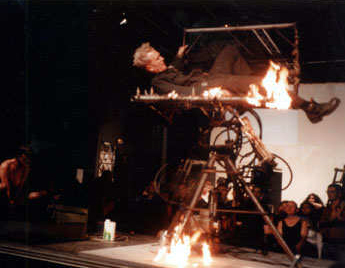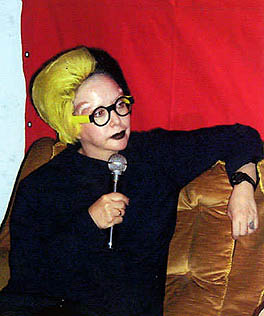|
PERFORMANCE: an assessment of public interest.
Performance in France
An increasing audience frequent contemporary art places, and
today, 40% of French people think that the budget dedicated to
culture is way too low, taking into account the importance of
its task, for the present time and for the future of our societies.
At that time, we can only assess the state of general decline
in which plastic arts are in France. They are becoming the "poor
parent" of culture because of the "laisser-faire"
politic of the state. The situation of Live Art is becoming very
serious, even explosive!
The assessment is that, in France, every initiative which does
not come from an institution is not taken into account with an
open-mind and if ever this initiative happens to come to life.....or
to survive, it has to be done in conditions which are close to.....a
performance! And anyways with a very small budget.
Then, in the middle of this depression, what can be said about
Performance Art, always considered as a minor art?
20 years before, Orlan and Hubert Besacier have known the same
problems with their Symposium of Art Performance from 1978 to
1983. Lyon had become the capital city of Performance Art and
their bravour and optimism has not been able to resist very long
to the lack of financial support.
It is curious to note that the situation has not developed since
that time whereas Performance is still up to date.
To shake the coconut palm of Lyon is quite a business.
Though the Polysonneries Festival is wanting to continue this
tradition, to be the link between the past and the relevance
of the most recent researches, and to maintain an atmosphere
of pluridisciplinary confrontations, meanwhile keeping a feet
strongly anchored in the field of visual arts. By inviting specialists
of various performatives practices, and critics or theorists
open to these original mixings, we can affirm the notable evolution
of these pluridisciplinary activities and introduce to an audience
always seeking authenticity the different states of Performance
Art in their international dimension.
 Polysonneries, 2001. Polysonneries, 2001.
HISTORICAL ACCOUNT.
If Performance consists in introducing a piece of art in the
process of beeing made, it also has its own history : Futurism,
Dadaism, Fluxus until Action Poetry, rock music, the net, video
art, sound poetry, new technologies.... and more.
Performance could be considered as the oldest and the most changeable
form of expression. The practice of the body can be noted in
every culture, at every time period of history and of humanity,
from prehistory until nowadays (as said Arnaud Labelle-Rojoux
in his book L'Acte pour l'art). "The word "performance"
according to Jacques Donguy appeared for the first timein
1970 with Mr. Hein in the "Journal of the Aesthetics".
It is in my opinion previous to that: Rauchenberg's actions
are usualy called performances, Suzi Gablik uses this
term in 69 in the journal: Pop Art redefinited.
David Medalla, as soon as 1965 says: " In performance
Art, the artist is the tool of art, he is art".
Linked to the 70's, Performance Art already appears during the
60's, remembering Ben Vautier, Gilbert & George and Joseph
Beuys's actions. In 1959 the American Allan Kaprow realized 18
happenings in Six parts at Reuben Gallery, and Jean-Jacques Lebel
"the Anti-Procès" in 1960.
But the purpose of the excessive happenings of Jodorowski, a
transitory panic gone up with Topor, Arrabal, Leyaouanc, was
to last no more than one day, and to leave traces which would
remain engraved inside the human beings and appear by psychological
changes
(" Melodrama sacramentiel ", 2d Festival of free expression
of Paris, May 1965, in the American Center).
In Poland, Zbigniew Warpechowski makes its first performance
in 1967, long before the word Performance appears in its country,
a word heard for the first time in Warsaw and in Lublin , during
the Festival organized by Henryk Gajewski and at the same time
in the BWA Gallery curated by Andrzej Mroczek in the year 1978.
In 1975 in Marseille, Roland Miller and Shirley Cameron quote
then the word " performer - artist ".
In 1968, in Lyon, Jean-Claude Guillaumon invites Ben, Filliou,
Dietman, Guinochet and George Brecht for a dinner on the topic
" to forget art and come eat with us ".
In 1969, Vito Acconci perform for the 1st time and Michel Journiac
made in the Templon gallery the " Messe pour un corps"
(mass for a body), an action during which he made the
public receive communion with his blood prepared in a blood sausage.
Reactioning since its origines, going against the official
art advocated by the institutions, one notices today that the
assertive side of performance has now been swallowed to open
to a wider field of actions, leaving it up to the artist the
whole liberty of use of new technologies on his disposal. Even
if there are still a few die-hard who claim and bug the "catholic"
establishment with somehow subversive actions, we note in the
Performance field a development as important as in other artistic
fields. (For example : in Canada, Istvan Kantor, In Mexico Guillermo
Gomez-Pena and La Pocha Nostra, in England André Stiit
and in France Marie-Claire Cordat,).
Istvan Kantor-alias Monty Cantsin- is well-known for his participation
for hundred of years to the bloody game of art as rebellion,
and of rebellion as art. He considers that in our technological
society, the surviving of peace is controled by massive destruction
machines. The sound of machinery creates and destroys all things.
"Executive Machinery" explores this situation in the
most extreme way: by the brutal closing of drawers of an office
shelving unit. By this post millenium noisy symphony of the trans-techno
music archangels of destruction, he uses his machines to make
a definitive but poetic declaration.
 I. Kantor I. Kantor
The actionnists.
All the publications about Performance make a big deal of
the school of Vienne (Nitsch, Muehl, Brus, Schwarzkogler), and
they are right! The strong content of pictures of their actions
is a phenomenom that all recognize; and a lot of performances
of actionnists occured with no audience, only in the aim of making
pictures and films.
In France, Michel Journiac, Gina Pane and Urs Lüthi represent
Body Art, in the USA, Vito Acconci. The term appeared in 1970
and arises from the idea that the body is the founding data base
and that it is inside of it that one has to seek for answers.
And later Orlan signs the "Carnal Art".
She defines carnal art as an autoportrait in the classical meaning,
but with the help of technological means, which are those of
our present times. Between disfiguration and refiguration. This
work inscribe in the flesh because our time period allow this
possibility.
 Orlan, 1999. Orlan, 1999.

|
|